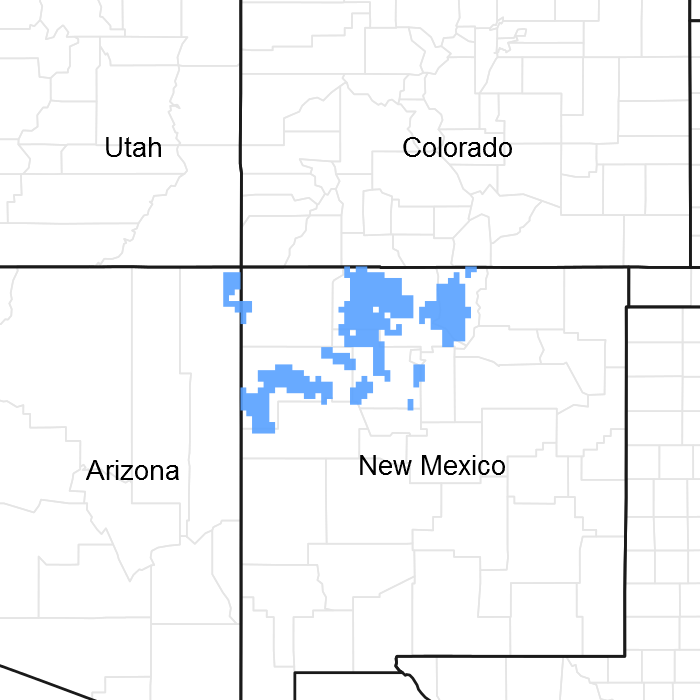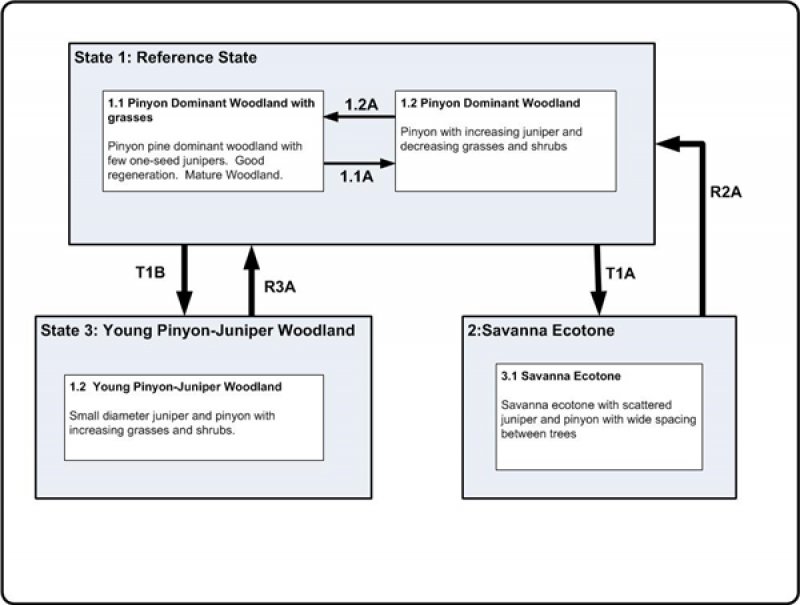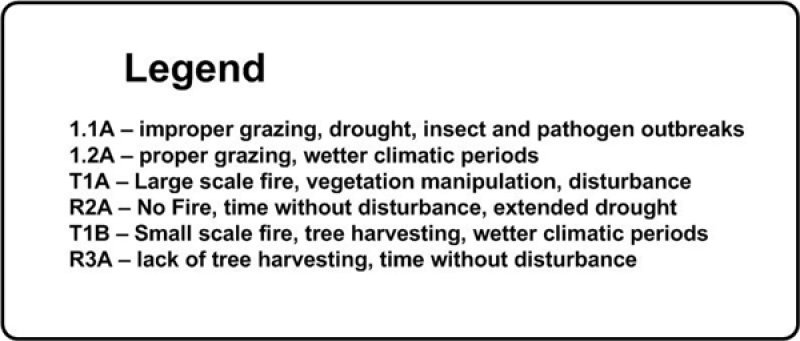
Natural Resources
Conservation Service
Ecological site F036XA001NM
Pinyon Upland
Last updated: 12/23/2024
Accessed: 04/25/2025
General information
Provisional. A provisional ecological site description has undergone quality control and quality assurance review. It contains a working state and transition model and enough information to identify the ecological site.

Figure 1. Mapped extent
Areas shown in blue indicate the maximum mapped extent of this ecological site. Other ecological sites likely occur within the highlighted areas. It is also possible for this ecological site to occur outside of highlighted areas if detailed soil survey has not been completed or recently updated.
MLRA notes
Major Land Resource Area (MLRA): 036X–Southwestern Plateaus, Mesas, and Foothills
F036XA001NM Pinyon Upland (Formerly South Of Gallup 13-16) is an ecological site that is found on hills, ridges and knolls in MLRA 36 (Southwestern Plateaus Mesas and Foothills). The southern portion MLRA 36 is illustrated yellow color on the map where this site occurs. The site concept was established in the Southwestern Plateaus. Mesas, and Foothills – Warm Semiarid Mesas and Plateaus LRU (Land Resource Area). This LRU has 10 to 16 inches of precipitation and has a mesic temperature regime. Lower part of MLRA 36 is dominated by summer precipitation for monsoons, unlike the upper part of MLRA 36 which is almost an equal split.
Classification relationships
NRCS & BLM:
Major Land Resource Area 36, Southwestern Plateaus Mesas and Foothills (United States Department of Agriculture, Natural Resources Conservation Service, 2006).
USFS:
313Bd Chaco Basin High Desert Shrubland and 313Be San Juan Basin North subsections < 313B Navaho Canyonlands Section < 313 Colorado Plateau Semi-Desert (Cleland, et al., 2007).
315Ha Central Rio Grande Intermontane, and 315Hb North Central Rio Grande Intermontane subsections <315H Central Rio Grande Intermontane Section < 315 Southwest Plateau and Plains Dry Steppe and Shrub (Cleland, et al., 2007).
315Ad Chupadera High Plains Grassland subsections <315A Pecos Valley Section < 315 Southwest Plateau and Plains Dry Steppe and Shrub (Cleland, et al., 2007).
331Jb San Luis Hills and 331Jd Southern San Luis Grasslands subsections <331J Northern Rio Grande Basin Section < 331 Great Plains- Palouse Dry Steppe (Cleland, et al., 2007).
M313Bd Manzano Mountains Woodland subsection < Sacramento-Monzano Mountains Section < M313 Arizona-New Mexico Mountains Semi-Desert - Open Woodland - Coniferous Forest - Alpine Meadow
M331Fg Sangre de Cristo Mountains Woodland and M331Fh Sangre de Cristo Mountains Coniferous Forest subsection < M331F Southern Parks and Rocky Mountain Range Section< M331 Southern Rocky Mountain Steppe - Open Woodland - Coniferous Forest - Alpine Meadow
M331Gk Brazos Uplift and M331Gm Jemez and San Pedro Mountains Coniferous Forest subsections < M331G South Central Highlands Section < M331 Southern Rocky Mountain Steppe - Open Woodland - Coniferous Forest - Alpine Meadow
EPA:
21d Foothill Shrublands and 21f Sedimentary Mid-Elevation Forests < 21 Southern Rockies < 6.2 Western Cordillera < 6 Northwestern Forested Mountains (Griffith, 2006).
20c Semiarid Benchlands and Canyonlands < 20 Colorado Plateaus < 10.1 Cold Deserts < 10 North American Deserts (Griffith, 2006).
22m Albuquerque Basin, 22i San Juan/Chaco Tablelands and Mesas, 22h North Central New Mexico Valleys and Mesas, 22f Taos Plateau, and 22g Rio Grande Floodplain, < 22 Arizona/New Mexico Plateau < 10.1 Cold Deserts < 10 North American Deserts (Griffith, 2006).
USGS:
Colorado Plateau Province (Navajo and Datil Section) Southern Rocky Mountains
Basin and Range (Mexican Highland and Sacramento Section)
Ecological site concept
The 36XB Pinyon Upland (Formerly South Of Gallup 13-16) ecological site was drafted from the existing F036XA001NM - South of Gallup 13-16 range site MLRA 36XB (NRCS, 2003). This site occurs on escarpments, fan plateaus. mesas and cuestas. The soil surface is sandy in textures. Common soil surface textures are fine sandy loam, loam or sandy loam. The effective precipitation ranges from 10 to 16 inches.
Associated sites
| F036XB133NM |
Pinyon-Utah juniper/skunkbush sumac Pinyon-Juniper/Skunkbush Sumac - Slopes are 1-65%; Soils are moderately deep to deep and skeletal and non-skeletal. Surface texture of gravelly to very gravelly sandy loam, very gravelly loam, loam, sandy loam, paragravelly-ashy loamy coarse sand, and extremely cobbly coarse sandy loam with a sandy subsoil. Landform is mesas, hills, fan piedmonts, valley sides, plateaus, mountain slopes, structural benches, breaks and ridges. |
|---|---|
| R036XB015NM |
Shallow Savanna Shallow Savanna - Slopes 1-55%; very shallow to shallow soils and non-skeletal; very cobbly loam, very cobbly sandy loam, loam, cobbly clay loam, and channery clay loam over a clayey subsoil. Bedrock can be sandstone, shale or basalt. Landforms narrow ridges, hills, breaks and mesas of bedrock controlled landscapes. |
| R036XB017NM |
Swale Swale - This site is enhanced by runoff during periods of high runoff (intermittent). The water table depth is greater than 6 ft. Soils are deep to very deep soils that have surface textures of loams, silt loams to clays with loamy subsoil. Landforms are broad valley bottoms, floodplains, and in depressions. |
| R036XB002NM |
Clayey Clayey - Slopes are 0-15%; Soils are moderately deep to deep; soil surface loam, clay loam, silty clay loam, and silty clay over clayey subsoil with textures of clay loam, clay to silty clay loam or silty clay. Landforms are stream terraces, valley floors, fan remnants, alluvial fans, dipslopes on cuestas, mesas, hills, and valley floors. |
| R036XB005NM |
Limy Limy - Slopes are 3-8%; Calcareous (very calcareous throughout the profile); soils are Non-skeletal and deep; surface is generally a silt loam and subsoil textures range from loam to silt loam. Landforms are gently alluvial fans and valley sides. |
| R036XB006NM |
Loamy Loamy - Slopes are 1-15%; Soils are moderately deep to deep; soil surface range from loam, gravelly loam, loamy fine sand, fine sandy loam, sandy loam, silt loam and clay loam. Subsoil is loamy and range from loam to clay loam. Landforms are mesas, plateaus, fan remnant, terraces, dipslopes on cuestas, and broad upland valley sides. |
| R036XB010NM |
Salty Bottomland Salty Bottomland - Water table 42-72” in depth; soils are deep, high in sodium, soils are gravelly to skeletal (15-35% rock fragments). Surface textures are loam, fine sandy loam, clay loam and silty clay loam with a subsoil of clay or clay loam. Landform is floodplain. |
| R036XB011NM |
Sandy Sandy - Slopes are 1-15%; soils are deep to very deep; Surface textures are loamy sand, gravelly loamy sand, loamy fine sand, fine sandy loam and sandy loam with sandy subsoil. Landforms are nearly level to gently sloping landscapes on dunes, fan remnant and alluvial fans. |
Similar sites
| R036XB015NM |
Shallow Savanna Shallow Savanna - Slopes 1-55%; very shallow to shallow soils and non-skeletal; very cobbly loam, very cobbly sandy loam, loam, cobbly clay loam, and channery clay loam over a clayey subsoil. Bedrock can be sandstone, shale or basalt. Landforms narrow ridges, hills, breaks and mesas of bedrock controlled landscapes. |
|---|---|
| F036XB133NM |
Pinyon-Utah juniper/skunkbush sumac Pinyon-Juniper/Skunkbush Sumac - Slopes are 1-65%; Soils are moderately deep to deep and skeletal and non-skeletal. Surface texture of gravelly to very gravelly sandy loam, very gravelly loam, loam, sandy loam, paragravelly-ashy loamy coarse sand, and extremely cobbly coarse sandy loam with a sandy subsoil. Landform is mesas, hills, fan piedmonts, valley sides, plateaus, mountain slopes, structural benches, breaks and ridges. |
Table 1. Dominant plant species
| Tree |
(1) Pinus edulis |
|---|---|
| Shrub |
(1) Artemisia tridentata |
| Herbaceous |
Not specified |
Click on box and path labels to scroll to the respective text.

